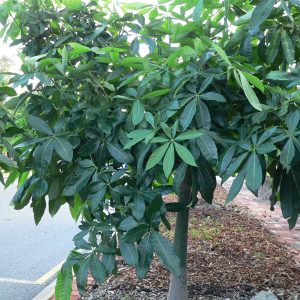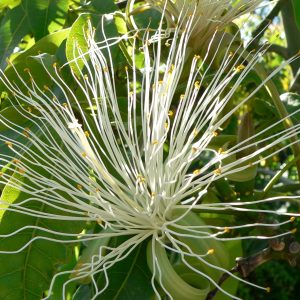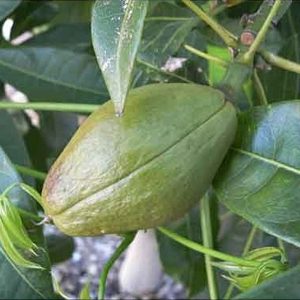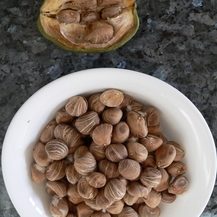Pachira (Bombacopsis) glabra
Saba nut, Guinea peanut, Guyana chestnut
Origin
Uncertain, with most proposing northern South America but Central Africa is also possible. The saba nut tree has been distributed throughout tropical parts of the world.
Climate
It is a tropical to sub-tropical species growing up to 1000m with average temperatures of 24°C, rainfall of 1000-2000mm pa and able to withstand brief light frosts.
Plant Description
Pachira is a small ornamental evergreen tree with a dense rounded canopy, 4-6m high. The trunk is smooth, greenish-grey and swollen at the base. Glossy dark green leaves are alternate, palmately compound and clustered towards the ends of branches. Long petioles usually carry 5 glossy elliptic leaflets, 5-25cm long and 2-12cm wide. Like many other tropical species, growth occurs in a series of flushes.
Relatives
Malvaceae family. Fruiting relatives include Malabar chestnut, baobab, durian and South American sapote. The naming of Saba nut and Malabar chestnut has long been confused by nurseries and others.
Soils
It grows best in fertile loams but is tolerant of sandy and clayey soils if they have reasonable drainage. It can even withstand some brief periods of water-logging.
Propagation
As seeds are easy to germinate, this is the main technique. However cuttings and root cuttings can also be used. In a few instances multiple seeds are produced by nucellar embryony; these grow more strongly and faster than the sexual forms. Seeds are recalcitrant but if sown fresh, germination is very fast (2 weeks) and almost complete. Thereafter however, seedling growth is slow and may take 3-5 years to attain 2-3m height.
Cultivars
It is a little-studied species and there are no established cultivars.
Flowering and Pollination
The large and showy perfect flowers are terminal on a long peduncle. Petals and numerous 3-4cm long stamens are white. There are 5 locular ovaries with a thick style up to 15cm long. Fruit set can be low and improved by hand-pollination. The means of pollination has not been established but it’s suspected that nocturnal moths may be involved.
Cultivation
Young plants should receive basic care regarding water, fertilization and protection from full sun. When mature, they do best in full sun while tolerating some shade. Traditionally, they have been grown as a low-management backyard tree producing multiple crops throughout the year without any input. However with less than ideal conditions, increased yields can be obtained with regular fertilization, plus watering in any dry periods.
Wind Tolerance
Seems reasonable.
Pruning
Only need to remove dead or crossing branches; size is usually not a major issue.
The Fruit
This a smooth green ovoid dehiscent capsule 5-12cm long which opens along 5 longitudinal sutures when ripe. There are usually 4-10 seeds per fruit surrounded by a thin layer of loose cottony fibres. Each seed is roughly the size and shape of a hazelnut kernel. The seed coat is light brown and patterned with white wavy lines. Kernels contain 30% high quality protein and 50% lipids.
Fruit Production and Harvesting
Seedlings may take 4-5 years to fruit whereas cutting-grown plants may be productive in half this time. Under tropical conditions trees may crop continuously, but with cooler conditions this may be reduced to merely one extended season. Fruit take 4-5 months to mature from fruit set, and yield continues to increase over several years.
Although best flavour is attained when fruit ripen and dehisce from the tree, this requires individual seeds to be collected from the ground; in addition, it has to be done regularly or some will quickly germinate. You may choose to inspect frequently and pick the fruit just as it starts to open and before it has scattered its seeds. Seeds will store for months in a dry environment.
Fruit Uses
Traditionally, the seeds have been eaten raw or roasted. However recent studies have shown they have anti-nutritional factors to deter predation, as occurs with many other seeds, grains and nuts (eg red kidney beans). Roasting, but not boiling, degrades these components adequately and has the added benefit of adding to flavour and allowing easier removal of the tough seedcoat.
Pests and Diseases
Relatively trouble-free.
Comments
This is a very hardy attractive small tree that grows easily here.



